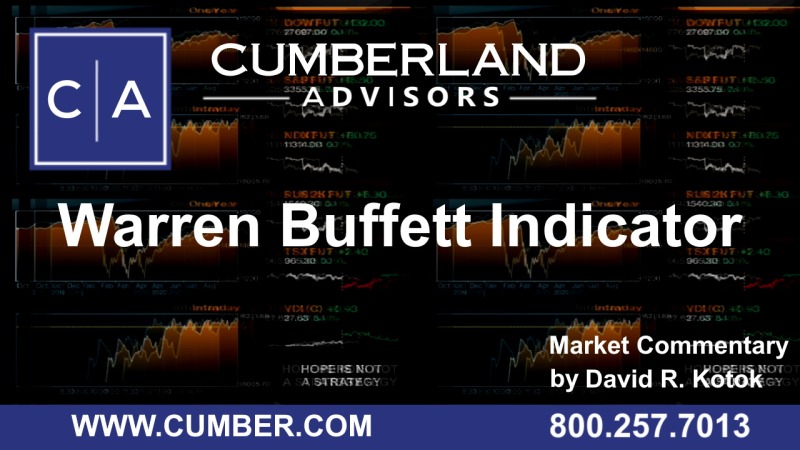
For a discussion about which market valuation to use, and for insights on whether GDP or GNP is the appropriate reference, we recommend reading the piece “Market Cap to GDP: An Updated Look at the Buffett Valuation Indicator” for background (a few comments follow the link): https://www.advisorperspectives.com/dshort/updates/2021/02/04/market-cap-to-gdp-an-updated-look-at-the-buffett-valuation-indicator
“With the Q4 GDP Advance Estimate and the January close data, we now have an updated look at the popular ‘Buffett Indicator’ — the ratio of corporate equities to GDP. The current reading is 189.6%, down from 176.6% the previous quarter.” (source: www.advisorperspectives.com)
- The idea behind the market cap to GDP indicator is quite simple. Corporate profits originate in the GDP. No GDP, no profits. One can make the same case for GNP if one adjusts for the differences. One can argue that the GDP ratio is better for a mostly closed economy, but GNP is better when the world is more open to trade and financial exchanges, as it is now versus decades ago.
- The second point is about what constitutes GDP or, rather, the change in GDP. In 2020, the US and most of the world had a shrinkage of GDP due to COVID and other factors. So, if a temporary shock reduced GDP, the ratio would have an overstatement bias if stock market pricing was unchanged. Profits in the Covid shock declined; GDP declined; but stock prices went up. Why? Because the stock market is looking at the future while the GDP and the earnings that come from it are reporting the present or the past.
- Many market agents call this a disconnect between Wall Street and Main Street. I don’t agree. The relationship between today’s shock and tomorrow’s rebound is intertemporal (meaning “between two time periods”). One has to expect that relationship to be dramatically changing when there is a once-in-a-century shock.
- GDP has two components: change in population and change in productivity. In 2020–2021, the US population was at best unchanged and maybe shrank. It suffered the regular, anticipated changes plus a largely increased death rate from confirmed COVID cases plus mystery deaths (lacking a COVID test result) plus excess non-COVID deaths occasioned by the circumstances wrought by the pandemic. The three categories make up the estimated total COVID-19 pandemic death toll, which, so far, is somewhere close to one million people. It makes little difference if the final number is one million or 800,000 when you consider the economics. The economic impact is huge whatever the exact count. And if one of those deaths is a family member or a friend or colleague, that loss makes a huge difference in our lives.
- Productivity certainly rose during the pandemic. It was forced higher by challenging conditions and by the acceleration of technology that those conditions warranted. Is this a temporary surge? A debate continues about that question, and we will probably know the definitive answer only after a few years pass. Our view is that some of the productivity gains will stick but not all. And the calculation of productivity is a residual. It comes after the fact and after revisions and after the other components are all added up. So we would call this outlook problematic for the big productivity gains to persist. That prediction is wishful optimism, certainly, but we hope and believe that it will prove correct.
Where does all this take us with stock market calculus and the Warren Buffett indicator? It takes us essentially nowhere. An investor can choose any indicator she or he wishes. We look at many of them. Some work some of the time. None work all of the time. Is the Warren Buffett indicator working now to tell you to sell all your stocks? Maybe yes. Did it say the same thing a week ago or a month ago or three months ago or six months ago? Yes.
For us, a more strategic indicator emerges when the GNP/GDP more closely aligns with longer-term trends. Right now that alignment is not the case.
Our US ETF portfolios remain nearly fully invested. We favor the renewable energy contingent (solar, wind, water) aligned with climate-change response. We are overweight the healthcare sector. We are overweight defense. We like materials and components that are needed for an infrastructure buildout. We believe all of these sectors will be adding to the GDP/GNP, and they represent areas of opportunity.
David R. Kotok
Chairman of the Board & Chief Investment Officer
Email | Bio
Links to other websites or electronic media controlled or offered by Third-Parties (non-affiliates of Cumberland Advisors) are provided only as a reference and courtesy to our users. Cumberland Advisors has no control over such websites, does not recommend or endorse any opinions, ideas, products, information, or content of such sites, and makes no warranties as to the accuracy, completeness, reliability or suitability of their content. Cumberland Advisors hereby disclaims liability for any information, materials, products or services posted or offered at any of the Third-Party websites. The Third-Party may have a privacy and/or security policy different from that of Cumberland Advisors. Therefore, please refer to the specific privacy and security policies of the Third-Party when accessing their websites.
Sign up for our FREE Cumberland Market Commentaries
Cumberland Advisors Market Commentaries offer insights and analysis on upcoming, important economic issues that potentially impact global financial markets. Our team shares their thinking on global economic developments, market news and other factors that often influence investment opportunities and strategies.

